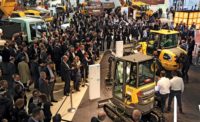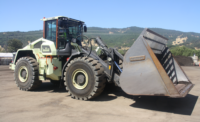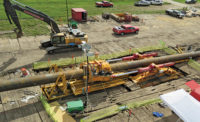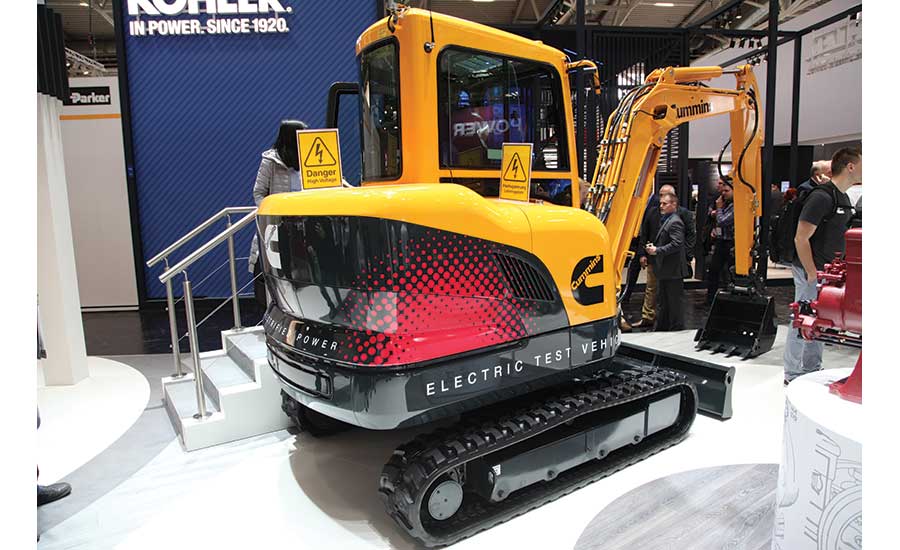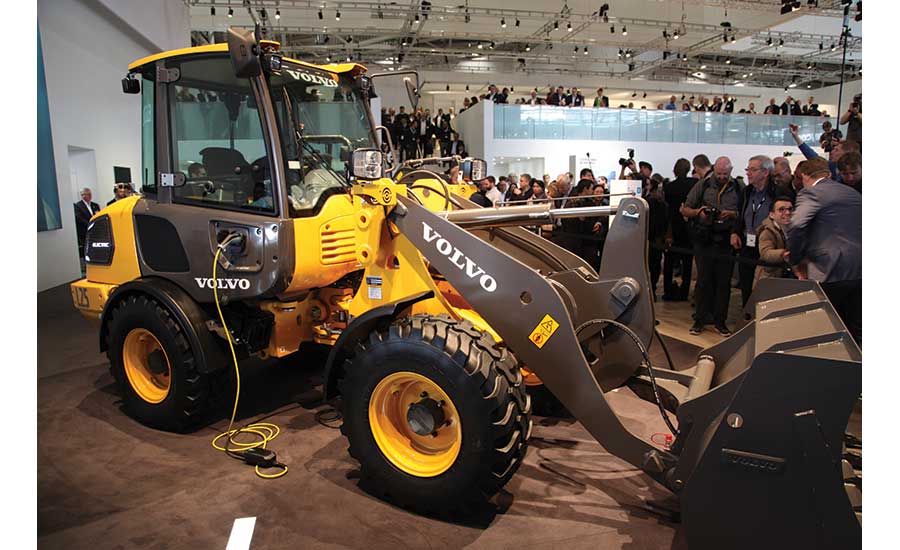Construction Equipment Goes Electric, But Hurdles Remain

Volvo CE is converting its entire compact line to battery power, seeing potential for urban construction.
IMAGE COURTESY OF VOLVO CE

Signs of a fresh look at electrification were seen at the Bauma equipment show in April, where Dana showcased its Spicer electric drivetrains, diesel engine maker Cummins displayed a concept electric excavator, and Volvo CE unveiled its new line of all-electric compact equipment. While much of this technology is tailored to the demands of the European market, manufacturers have told ENR that they expect electrification to happen in certain machine categories in the near future.
PHOTO BY JEFF RUBENSTONE / ENR

Signs of a fresh look at electrification were seen at the Bauma equipment show in April, where Dana showcased its Spicer electric drivetrains, diesel engine maker Cummins displayed a concept electric excavator, and Volvo CE unveiled its new line of all-electric compact equipment. While much of this technology is tailored to the demands of the European market, manufacturers have told ENR that they expect electrification to happen in certain machine categories in the near future.
PHOTO BY JEFF RUBENSTONE / ENR

Signs of a fresh look at electrification were seen at the Bauma equipment show in April, where Dana showcased its Spicer electric drivetrains, diesel engine maker Cummins displayed a concept electric excavator, and Volvo CE unveiled its new line of all-electric compact equipment. While much of this technology is tailored to the demands of the European market, manufacturers have told ENR that they expect electrification to happen in certain machine categories in the near future.
PHOTO BY JEFF RUBENSTONE / ENR

Cat Zeppelin has an electric compact excavator that runs off of line power from an electric motor, but hasn’t offered a battery version.
PHOTO COURTESY OF CATERPILLAR





Electric-powered equipment has been adjacent to construction for some time. Electric machines are a common sight in mining, while indoor loading and material-handling equipment have long relied on battery power. But construction sites haven’t seen much electric equipment aside from the odd forklift or scissor lift. On-site power can be spotty, and recharging batteries can be a pain.
But that’s changing as some major manufacturers seize upon recent advances in lithium-ion battery technology and gradual improvements in the drivetrains and motors used in on-road electric vehicles. There are still major hurdles to bringing battery power to larger machines, but some companies are taking a chance on electrifying construction equipment.
“We see electric machines as a growing category,” says Scott Young, director of electromobility and automation for Volvo Construction Equipment. Volvo CE has already laid out its cards for electric equipment, pledging in January to cease development of diesel-powered compact equipment and shift the product line entirely to battery-powered electric starting next year.
Production-ready electric compact machines were the centerpiece of Volvo CE’s display at the Bauma equipment trade show in Munich in April (ENR 4/22 p. 12), drawing crowds of onlookers curious to see whether the company had made good on its promise to have production-ready machines and not just another concept vehicle.
“The customer response at Bauma was very positive, especially since they could see the way the machines looked, and see that this is a real-life product,” says Young.
The initial launch from Volvo CE will include two models that were showcased at Bauma, a compact excavator and a compact wheel loader. The machines will launch in mid-2020, initially in Europe and then eventually in other markets. The L25 is a 4.9-tonne compact wheel loader running on a lithium-ion-based battery pack. According to Volvo CE, it can hold enough of a charge for an entire eight-hour duty cycle. It can be fully recharged from a standard European 230-V AC outlet in 12 hours, or get up to 80% charge in two hours using a proprietary fast-charging system Volvo CE is developing.
The other electric machine unveiled at Bauma was the 2.5-tonne ECR25 compact excavator, which also promises an eight-hour runtime on a single charge. It can recharge off standard power in only six hours, or in one hour using a fast charger. These machines are the only ones publicly revealed so far, but Volvo CE has said that the full electric lineup available next year will include up to ten models. All will run on a common 48-V lithium-ion battery platform.
Volvo CE’s shift to electric is being spurred by its parent, the Volvo Group, which has committed to drastically reducing the use of fossil fuels in its products. Large strides have been made in Volvo Bus and Volvo Truck’s electric offerings, and many of the advancements in battery technology there can be adapted for equipment, says Young. “There is a performance ceiling, but it is continuing to move up,” he says. “As the power and energy density of batteries continues to improve, it opens up new equipment categories for us.”
Young adds that in addition to adapting battery and electric drive technology from the Volvo Group’s other divisions, there are lessons to be learned from other sectors as well. “As the technology comes out of automotive and mining, we can see ourselves moving up from these smaller [size] ranges of products,” he says.
|
Related Article |
Electrics From Mining?
When considering electric-powered heavy equipment, there’s one industry that already has years of experience deploying machines on site. Out of necessity, underground mining often uses electric machines to reduce issues with ventilation and air quality. But these machines are built for a specific purpose, and some of their manufacturers don’t believe the massive electric-drive trucks or battery-powered underground machines make great templates for electric construction equipment. “You’ll see a push toward electrifications underground, but that’s being driven by the need for [breathable air],” says Kurt Moncini, senior product manager with Komatsu Americas. “They’ll be on the forefront due to atmospheric needs, but it’s not the same as construction.”
“I believe it will change the ways that people are able to work”
– Scott Young, Volvo CE
Komatsu has established a large presence in the mining sector since its acquisition of Joy Global in 2017. But Moncini says that Komatsu isn’t really focused on bringing any fully electric equipment to construction. Instead, he sees more potential in furthering development of diesel-electric hybrids to lower emissions and reduce fuel usage. “I think you’re going to see more hybrid machines for the time being versus growth in electrics,” he says, noting the install base for diesel-electric hybrids is still growing. “Hybrids are here to stay.”
But when it comes to the broader use of full electrics in construction, Moncini sees it as a niche product that won’t see broad adoption for general construction. “Ten years ago when we started to bring electrics to excavators, in a very early form of a hybrid, we looked at the power density, and full electrification just wasn’t going to happen [at that size class of machine].”
Komatsu isn’t the only company skeptical of battery-powered electrics. Caterpillar declined to comment to ENR on its current internal research into battery-powered equipment, but did cite a statement it released in April where the company reiterated its commitment to diesel-electric hybrids for its dozer line, and was skeptical of full electrification. Cat also highlighted recent innovations from some of its European partners, including a mini excavator that had been adapted by its German dealer Cat Zeppelin to run off of an external electric motor via a power cable.
It’s not a coincidence that a German dealer would be toying with electrification. Several cities in Germany, including Cologne, Stuttgart and Berlin, have explored banning or limiting older diesel-engine vehicles from their city centers. There is some concern that these regulations could apply to equipment as well.
But electric equipment could offer some advantages over diesel on urban jobsites beyond regulatory compliance. Work is scheduled to mitigate noise issues, and emissions prevent equipment from being used in indoor and underground areas. Electric equipment doesn’t have those problems, and Volvo CE’s Young thinks it will open up new ways of staging jobsites in dense urban settings.
“With smaller electric equipment in cities, we can run the machines much closer to the public, and it becomes a very different sort of environment,” says Young. “The fact that you are lowering noise levels, able to work indoors with the same equipment—it really opens things up. I believe it will change the ways that people are able work.”
Don’t Forget To Recharge
Integrating electric equipment into a fleet would require some effort. In addition to training workers to maintain and repair the equipment, there’s the need to keep machines charged, and while Volvo CE is experimenting with a mobile fast-charging station, the current plan is for machines to have on-site power or be returned to an equipment yard at the end of the day.
While it is a different plan than refueling diesel machines, Young says this new class of equipment will change they way fleets are managed. “It’s like when you have electric cars, it changes your driving mentality, how you plan out your day,” says Young. “You’re going to see similar things happen with construction equipment.”
If battery power is coming to compact equipment, rental channels will likely have to adjust, where small machines are a popular product. But are the rental giants ready to handle machines that require overnight charging or fast-charging units on site? “[Today] we have a variety of options from various manufacturers that are either hybrid—usually DSL and battery with charging capabilities—or straight battery powered,” explains United Rentals’ Mike Jordan, director of the company’s fleet division. “We continue to evaluate battery and hybrid technology options for our customers, especially in smaller dirt units such as skid-steer loaders, compact track loaders and mini excavator units as they’re offered.” Jordan and United Rentals declined to expand further on exactly which electric technologies the company was currently considering.
But the question of recharging is bigger than just finding an empty outlet to plug in your machine. Different standards could lead to problems in mixed fleets, and if the electric automobile market is any indication, fast-charging technologies are often proprietary and not always compatible. “There has been some discussion around charging standards, but nothing has been decided,” says Young. “Industry groups are trying to look at what might be the regulatory aspects of this, but right now we’re keeping a close eye on on-road electric infrastructure, to track with where that goes.”
But while he sees promise in battery power, Young says Volvo CE will use a combination of electric equipment, diesel-electric hybrids and other technology to meet its decarbonization goals. “We have believed in going in this direction for some time, and all of these things have come together to make this a reality.”


